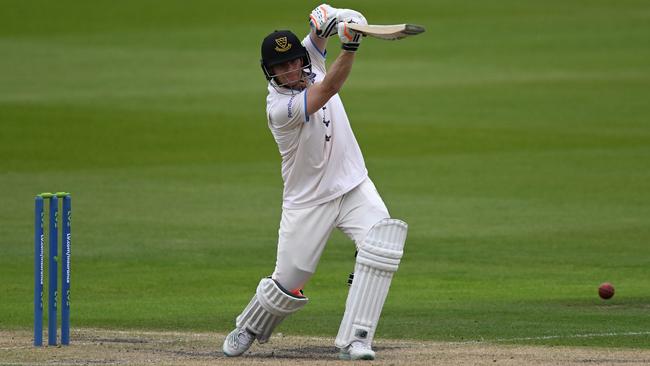The WTC final is cricket’s lip service to a format with a clouded future

A final is, normally, by definition the last game one plays. But next week Australia will start its northern summer with a final, the World Test Championship, ahead of its most prestigious and storied series, the Ashes.
Yes, Australia, the number one Test nation, will play a single match against India, number two, as what most fans will view as a warm-up to five matches against England, number four. That this WTC final be the first Test in 143 years that The Oval has hosted in June is really one of the less weird things about it. All this is occurring in arrears of the world’s richest cricket event, the Indian Premier League, which is so old-fashioned that they still play the final at the end.
The England Cricket Board now intends front-ending its Test season in order to devote August to its tenth-rate IPL knock-off, The Hundred. So here we are.
The prospect of Australia v India at The Oval should by rights be pleasing. No, let’s be fair. It is pleasing, quite: here are two well-matched teams, consistently the best of the last two years and full of quality players, who can play five bowlers and still bat deep.
Their recent meeting in the Border-Gavaskar Trophy was undermined by shit-tip pitches, but The Oval seems to offer probably the fairest surface possible, with a hint that runs on the board will matter. In the venue’s last ten Tests, the team batting first on winning the toss has won four times, drawn once and lost once; the team fielding first on winning the toss has won twice and lost twice.
England took the latter course last year and bundled South Africa out for 118, but the Proteas’ top order these days is like an Ikea kit without the instruction booklet.
The northern summer has so far been dry, the skies look pretty clear for the next fortnight, and the average first innings score in the County Championship at The Oval has been around 300.
Australia may have the slightest edge. Pat Cummins’ team will be the fresher, himself included. Steve Smith and Marnus Labuschagne have acclimatised in county cricket. The bowlers are well rested.
The squad is at full strength, that ugly blow to Cameron Green’s arm in his last IPL engagement having proven less serious than one first feared, while Scott Boland is the ideal proxy should Josh Hazlewood not come up.
India have both enormous experience, with Cheteshwar Pujara grinding runs out for Sussex lately, and ample flair, with Shubman Gill probably the world’s hottest batting property at the moment.
But they have lost four and drawn one of their last ten Tests abroad even as their strength at home has grown – the two may not be unrelated. They still lack Jasprit Bumrah, Shreyas Iyer and Rishabh Pant – perhaps indefinitely in the case of the last.
Which is why, I suspect, they will be sorely tempted to go into the final not with Pant’s replacement during the Border-Gavaskar Trophy, KS Bharat, but Rohit Sharma’s Mumbai Indians’ exuberant opening partner, Ishan Kishan.
In India, Bharat rather failed to meet the standards of an elite gloveman; uncapped Ishan probably won’t ever, but the brio of his left-handed batting is the nearest his country have to a like-for-like Pant substitute.
Ishan’s 14 one-day internationals include a 131-ball 210 against Bangladesh six months ago, and his freedom at number seven would be enhanced by the presences of the Ravis, Jadeja and Ashwin, at numbers six and eight. He’s 24, ripe and dauntless.
But again, to step back a little, what’s discouraging about the World Test Championship Final is that the occasion must be enjoyed, in the words of Viktor Frankl, in spite of everything.
There is virtually no lead-in for expectation to build; there is no pause afterwards to savour its events or significance; four days separate it from the Edgbaston Test. You must squint in such a way as to overlook that the World Test Championship itself is bonkers. One team has played as many as 22 Tests (England), others as few as 12 (Bangladesh and Sri Lanka); three other Test nations (Afghanistan, Zimbabwe, Ireland) do not even compete, having been allotted a total of half a dozen Tests in the last two years.
While Tests are traditionally played in series hosted by one nation or other (viz the Ashes), the final is a one-off in a neutral venue, far from the fans of the participating countries, muting the overall effect, reducing a global showpiece to a boutique property.
Finally, the WTC final is another expression of cricket’s devil’s bargain. It depends for its commercial viability on India playing in the final, bringing some of its vast television audiences – even as the politically-squalid Board of Control for Cricket in India connives to suck the marrow out of the rest of the international game.
So let’s be absolutely frank: as terrific as the cricketers will be on show from next Wednesday, as exciting as the potential of their rivalry, the WTC final is cricket’s lip service to a format with a clouded future. Which is a thousand pities.
Cricket will pause momentarily, then revert to the far more pressing business of making money. After the Headingley Test, in fact, it will be time to tune in to the likes of the San Francisco Unicorns (captain Aaron Finch) and the Washington Freedom (captain Moises Henriques) in the US’s Major League Cricket. I haven’t checked, but imagine they also have the final at the end.



Cricket scheduling keeps finding ways to make itself a darker art.